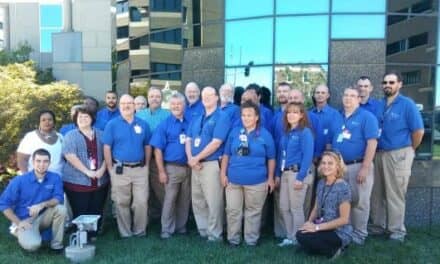By Chris Hayhurst
It’s a good time to be in healthcare technology management. Organizations are hiring, pay is increasing, and HTM itself is becoming more and more important as medical devices evolve to improve patient care. Yes, there’s the coronavirus crisis, a challenge unlike any the field has ever seen before. But if you ask around, few are complaining; they’re simply rising to the occasion because that’s what their job demands.
Against this backdrop of a thriving profession, a growing number of HTM leaders are doubling down on the development of their departments. Looking to improve efficiencies and reduce costs—but also with the knowledge that their best employees could easily find other jobs should they wish to do so—they’ve recognized how critical it is to provide their staff with the support and resources they need to flourish both as individuals and as part of a greater team.
How this work looks, and its impact on staff, varies from department to department, of course. But ask around and what you’re likely to hear is something about the importance of “organizational culture.” As the Society for Human Resource Management (SHRM) explains, successful organizations invariably have a culture “based on a strongly held and widely shared set of beliefs that are supported by strategy and structure.” A strong organizational culture, SHRM continues, “sets the context for everything an enterprise does” while the absence of such a culture often leads to “disengaged employees, high turnover, poor customer relations and lower profits.”
In the context of healthcare, others have noted, a strong organizational culture can drive improvements in patient safety and care quality, and it can be the key to financial success. A healthcare organization with a clearly defined vision—and a roadmap employees can follow to achieve it—stands to do better over time. Staff in such an enterprise want to come to work because they see they can make a difference and believe it really matters. They approach their jobs with greater passion and positivity, which in turn helps them be more productive and effective.
24×7 Magazine reached out to two HTM departments—at ChristianaCare in Wilmington, Del., and at Cincinnati Children’s Hospital Medical Center in Ohio—to get their thoughts on how organizational culture affects company success and personnel motivation and satisfaction. At Cincinnati Children’s, we spoke with Glenn Schneider, CRES, MHSA, who as director of clinical engineering oversees a team of 41. And at ChristianaCare we talked with three HTM staff: senior biomedical technicians Wendall Dale and Anne Wilkinson and radiology services technician Catherine White. Here’s a look at what they had to say.
Cincinnati Children’s. Hospital Medical Center
At Cincinnati Children’s, Schneider says, the organizational culture revolves around open employee participation at every department level. “What they promote across the organization and what we promote in our department is that everyone should feel free to speak up at any time with anything that’s on their mind.”
If someone sees something that seems unsafe, for example, or thinks they’ve found a better way to accomplish a project or task, they know they won’t be judged or punished for sharing their thoughts, he explains. “There’s no wrong answer, there’s no bad idea. That doesn’t mean your idea is going to be used, but the culture is, if you have a suggestion, it’s going to be evaluated. That may take 30 seconds, it may take a week, but it’s going to be evaluated for its validity and if it’s something we can do.”
That philosophy has been embraced by the organization for as long as he has been there, Schneider says, but up until a few years ago there was no concerted effort to put it into practice. “Department leaders have to come out and say it: ‘Look, I’m not on the front line, I’m making decisions based on input I’m getting from people. So if you’ve got another idea, please tell us about it. Don’t keep it to yourself.’”
To get that across in clinical engineering, the department meets twice per month—once in the morning and once in the afternoon. That gives employees from all three of the department’s shifts an opportunity to attend and participate, Schneider says, “and we really encourage everybody to at least make it to one.”
A second defining culture at Cincinnati Children’s is its focus on Lean management and workflows, which strive to reduce inefficiencies in processes. Employees attend classes to learn basic Lean principles and are encouraged to apply them to their departments and to their personal day-to-day work. “It’s about always looking for ways to improve and never just saying we’re where we need to be,” Schneider says. “We don’t want to become complacent and think that we’re doing everything as well as we can. There’s always room for us to do better.”
How this plays out in the real world depends on the situation, but Schneider points to one project from a few years ago to illustrate how Lean thinking drives success at the organization. The system they had in place for processing infusion pumps involved reacting to the organization’s needs rather than anticipating those needs in advance, he recalls.
“When we started, we had equipment sitting on racks waiting for repair and we’d fix it as needed” to meet the requests for pumps from the organization’s various clinical departments. “Each day the call would come up that they were running low on this or that, and our team would go out and find anything they could on the racks that fit that description and then bring it in and fix it to get it back into the pool.”
Hoping to improve the process to stay ahead of demand, Schneider worked with a dedicated Lean coach to reduce their pump turnaround time. “We had equipment that was sitting on that rack for way too long—in some cases, up to 40 days.” Soliciting input from across the department, and not just from those responsible for pump maintenance and cleaning, they looked at the process from every angle for things they might do differently and more efficiently.
“We met weekly and sometimes daily and basically just asked people to brainstorm ideas—what steps can be eliminated here, where can make a change that might speed this up?” That input would then be incorporated into the workflow, and the pump team would report back at the next meeting. “It was, ‘Hey, here’s what we did. We couldn’t do exactly what you suggested, but we did do this or this, and this is what happened.’”
At the start of the project, Schneider says, the consensus was that if they did everything perfectly they might get their turnaround time down to 4 days. Two months later, however, they’d easily surpassed that goal. “In the end, we got it to 2 days, and it kind of became this perfect example of what you can do when everyone’s on the same page, doing their part. When you succeed and you see the results of your work—that’s how organizational culture is developed.”
ChristianaCare
Cultivating a culture of collaboration is also important at ChristianaCare, where about 35 staff in clinical engineering serve three main hospitals and close to 130 outpatient sites. “I think here it all starts with our director and the open-door policy he has with employees,” says Wendall Dale, who’s been with the organization for more than 22 years.
Blake Collins, he notes, “is a hands-on leader, and that kind of trickles down to all of us in the department in the way that we respect each other and work together, and the way we feel comfortable coming to one another.” If someone has an issue they’re struggling with, Dale explains, they know they can seek advice from any of their coworkers. “We all support each other with whatever we’re doing; there’s nothing wrong with asking for help.”
Dale’s colleague Catherine White also points to Collins’s strong leadership as critical to the department’s inclusive culture. “And I think that reflects our organizational values of love and excellence,” which ChristianaCare officially adopted in 2016.
Every month, Anne Wilkinson notes, the department holds a meeting that starts with an icebreaker. “It’s usually something silly, like, ‘If you were a cartoon character, what would you be?’” That gets people laughing and loosened up, and then everyone is offered a chance to say something—whatever happens to be on their mind. “If there’s someone new in the department, it’s a chance to get to know them. Or if you want to thank somebody, or have something you want to discuss, it’s kind of a free forum where there’s no negative feedback and you just go ahead and say what it is you need to say.”
Regular smaller meetings for the department’s specialty teams are also built into the schedule at ChristianaCare, as are weekly Tuesday-morning huddles where plans are laid out for the work that lies ahead.
That time together, and the support they get from leadership, creates a sense of camaraderie in the department that is hard to explain to outsiders, says Wilkinson, who’s been with ChristianaCare for a little over three years. “When someone asks you to do something, you want to say ‘yes’ no matter what, because you know they’re going to do the same for you. You wind up doing all kinds of extra jobs and extra projects, but it’s just because you’re eager to help out. When you like your work, it’s just what you do. It’s hard to say no.”
White agrees with Wilkinson and points to the flexibility that she and her colleagues are offered to juggle work obligations with their personal lives. “We’re allowed to manage our own daily operations, so there’s no one telling you, ‘you need to be here now,’ or ‘work on this equipment next.’ It’s up to you to get the work done on time, and you can go about that in a way that works for you.”
ChristianaCare’s leadership is always telling them that family should come first, she adds. “So, if there’s something that we have to address at home, or there’s something going on outside of work, they’re going to support us 110%. They’re very big on work-life balance, which for me makes me want to come in here every day.”
For her part, Wilkinson says, she remembers interviewing for her position and learning that at ChristianaCare everyone, including the biomeds, is referred to as a “caregiver.” The idea, she explains, is that even though an HTM professional might not interact with patients, “because we’re fixing the equipment they’re using, we’re really just one step away.” That was a new way of thinking for her, she says, but one that she was happy to embrace. It helped her to see that her job was just as important as anyone else’s, “and knowing that the organization saw it that way too—that’s was really nice to hear.”
Also during that interview, Wilkinson recalls, Blake Collins said something revealing about his personal management philosophy that sealed the deal for her. “He said, ‘a full employee is a happy employee,’ and that they always buy lunch and keep sodas in the fridge.” Immediately, she says, she knew she had to work there—not necessarily for the free food, but because it symbolized something much greater.
“It’s such a small thing, but again, it’s the culture. It makes a huge difference because you feel appreciated. You get to do this amazing job, and then on top of that, they give you lunch?” When she heard that, Wilkinson remembers, “I was like, ‘Yeah, that’s the kind of place that I want to work.’”
Chris Hayhurst is a contributing writer for 24×7 Magazine. Questions and comments can be directed to chief editor Keri Forsythe-Stephens at [email protected].





